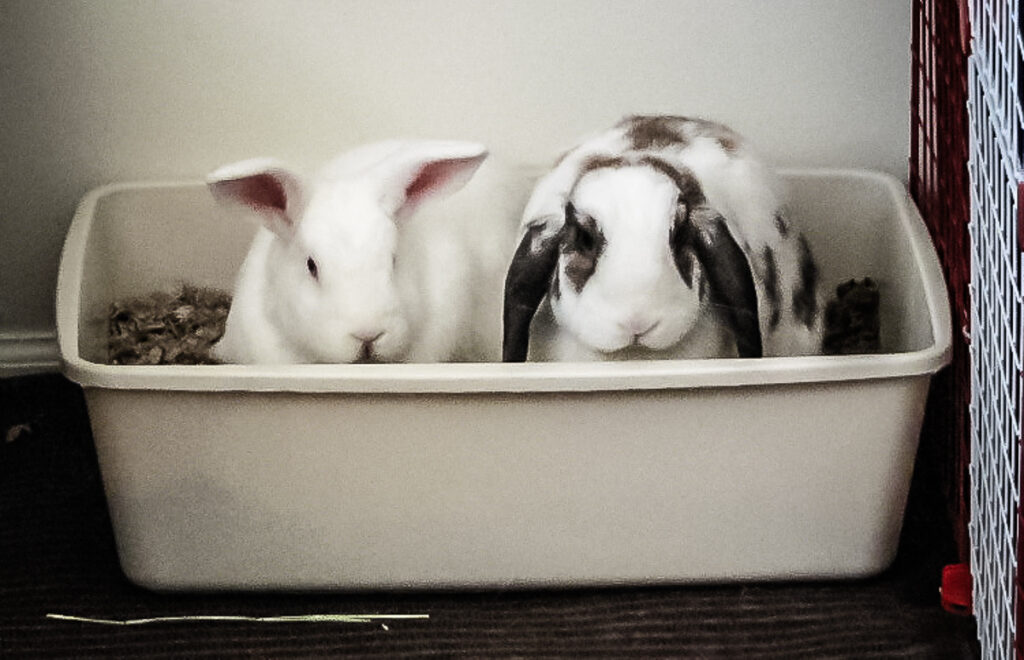In consultation with Marliss Geissler, DVM, and Carolynn Harvey, DVM
Choice of litter and bedding material has always been based on individual preferences. We now have reason to believe that real health factors must also be considered.
WHERE QUESTIONS BEGAN
We (fosters in the Bay Area) are not used to losing rabbits due to routine spaying or neutering. We lost one this past summer. An autopsy revealed liver disease. We already knew that a defective liver is unable to filter anesthetics, and we had been screening by blood panel for this condition in rabbits over 2 years old.
The fact that Sarah was only 18 months caused us to lower our age recommendations for a blood panel prior to surgery (HRJ, Vol.1 #9).
As we began preoperative screening among our foster rabbits and check-ups on our family rabbits, a disproportionate number of rabbits showed elevated liver enzymes (excess liver enzymes in the blood indicate leakage from the liver, which is not handling toxins adequately).
Both Tinker Bell, a large Californian, and Dinah, our gold mini-lop, showed elevated liver enzymes. The final results of an autopsy on a rabbit with a degenerative illness indicated the primary cause of death was liver disease, and Sarah had just died of liver failure after surgery.
We asked our vets, “What are we doing wrong?” In our carefully planned, loving foster homes are we providing a toxic environment?
PROCESS OF ELIMINATION
In our search for possible causes, we could find no common factors in age, weight, body-type or breed. Phoebe, our 6-year-old, overweight English spot, and Mimi, our 1 year old French lop, had perfectly normal livers; yet some of our younger, slimmer rabbits did show liver disease. We finally thought of the pine shavings in the litterboxes and cage trays. All of our rabbits who had elevated liver enzymes were using pine shavings in their individual litterboxes and/or cage trays. Mimi had not been given a litterbox because of a chronic bladder infection, and Phoebe, who is free-running, uses the cats’ litter-box (with clay litter) on the floor.
TESTING AND RETESTING
In order to check out our suspicions, we removed the pine shavings for a period of time and did the blood tests again. Nothing else in the rabbits’ environment was changed. Results were consistent when we began retesting a month later. Liver enzymes were back in the normal range. Meanwhile, opportunity allowed us to conduct an informal survey. As HRS members in various parts of the country reported deaths of their rabbits due to liver disease, we asked what type of litter was being used. It has been invariably some kind of softwood shavings.
Although our data do not qualify as a truly scientific experiment, there is enough evidence to suggest using caution. Documented scientific research has already shown that aromatic softwood beddings are potent enough to alter biological functions of the liver.*
What is it in the wood that’s doing damage? Apparently it’s not a result of ingesting but rather inhaling the fumes, which contain phenols, or toxins which pass in the fumes from the lungs to the blood and are finally filtered through the liver.
The fact that a large number of indoor house rabbits live in an environment of pine or cedar may account for the large number of deaths due to liver damage and anesthesia fatalities.
A CAUTIOUS APPROACH
For a safer use of shavings, keep them in large, open, ventilated areas only, and get your bunny’s blood checked every few months. Blood panels are now inexpensive since basic lab work is done in most veterinary offices.
New organic litters have been developed by several companies, and include CareFresh, Cat Country, Critter Country and Yesterday’s News.
Here are a few that we have tried:
Carefresh – is dust free, lightweight, super-absorbent, non abrasive, and non-toxic, this is currently in use in many foster homes. Use the product labeled Carefresh Natural only.
Cat Country – an organic grass-based pellet.
Critter Country – an organic grass-based pellet.
Oxbow Comfort Bedding – an organic grass-based pellet.
Yesterday’s News – This is a paper-based product and very good for rabbits.
Straw alone can be used as litter in a large litterbox on the floor. It’s too untidy to use in small boxes inside the cage. Absorbency is similar to rice hulls, and the boxes must be rinsed with every litter change.
Shredded paper popular with veterinarians and animal shelters where animals are kept in kennels. However, we found that it tempted some of our rabbits to excessive chewing.
Aspen pellets – inexpensive, highly absorbent litters used in many foster homes. They are made from hardwood and they are not toxic because the phenolic compounds are removed during their manufacture. Their wood composition helps control bacterial growth and odors. Wood stove fuel pellets and Feline Pine are two examples of this product.
LITTER COMPARISONS
| DUST | ABSORPTION | HEALTH HAZARDS | DISPOSAL | |
| Paper Pulp | Low | Good | None observed | Can be flushed, bagged or composted |
| Dry Grass Pellets | Low | Good | None observed | Can be flushed, bagged or composted |
| Generic Clay | High | Good | Irritating to eyes and respiratory tract | Heavy. Unsuitable for garden compost |
| Dustless Clay | Low | Good | Irritating to GI tract if swallowed | Heavy. Unsuitable for garden compost |
| Shredded Paper | Low | Fair | Excessive ingestion may cause blockage | Can be bagged for disposal service |
| Corn Cob | Medium | Fair | Fungal spores may cause mold, can cause fatal blockages if ingested | Can be composted for garden |
| Straw | High | Poor | None (unless allowed to mold) | Bulky but light. Can be composted |
| Pine Shavings | High | Good | Phenols may cause liver damage | Can be composted |
| Cedar Chips | Medium | Fair | Phenols may cause liver damage | Use as mulch around trees & shrubs |
| Chemical Sand | Medium | Good | Causes deadly blockages in GI tract when ingested. | Can be flushed |
| Peat Moss | Medium | Fair | High in nitrogen (swallowing unlikely) | Can be added directly to garden soil |
| Compressed sawdust pellets | Low | Good to Excellent | None observed. | Can be bagged or composted. |
| Silica-gel litters | Medium | Good | Toxic if eaten; must be placed where rabbits can’t eat. | Must be bagged for disposal service. |
| Pectin-based litters | low | Good | Will cause GI problems or obesity if eaten to excess. Will not hold down bacterial growth. | Can be bagged or composted. |
| Oat-hull litters | low | good | Will cause obesity of eaten to excess. Will not hold down bacterial growth. | Can be bagged or composted. |
*Vesell, E.S. (1967) Induction of Drug-Metabolizing Enzymes in Liver Microsomes of Mice and Rats by softwood bedding. Science. 157, 1058
Cunliffe-Beamer,T.L., et al. (1981) Barbiturate Sleeptime in Mice Exposed to Autoclaved or Unautoclaved Wood Beddings. Laboratory Animal Science 31(6), 672-675
©Copyright Marinell Harriman. All Rights Reserved. Republished with the permission of the author.
Litterboxes and Liver Disease was originally published in House Rabbit Journal Volume I.

